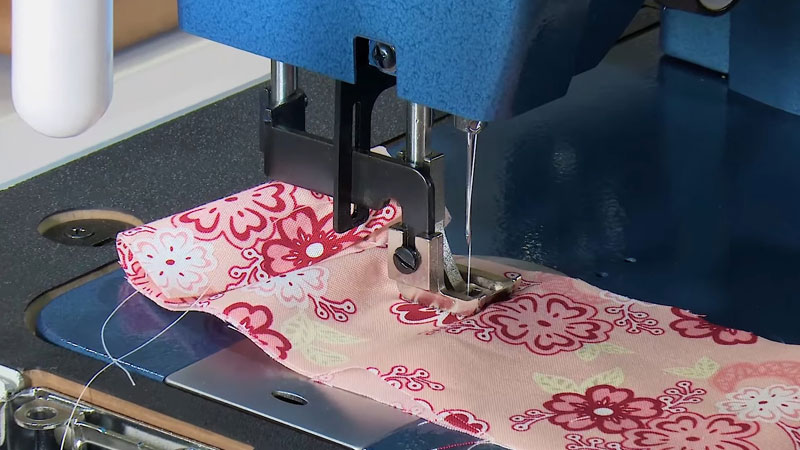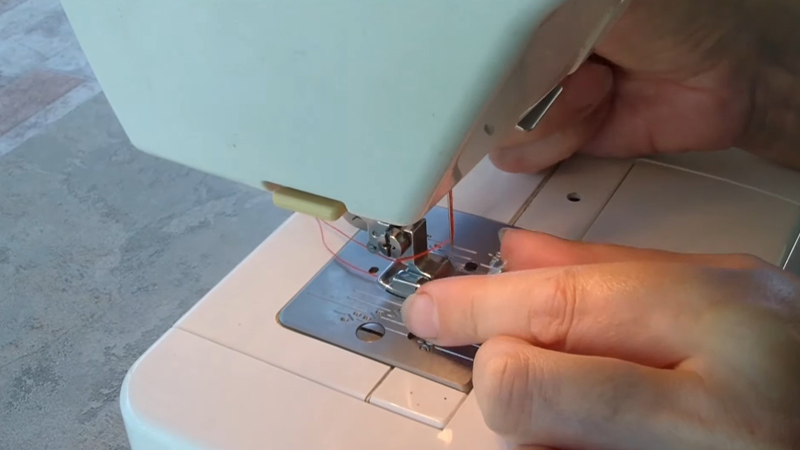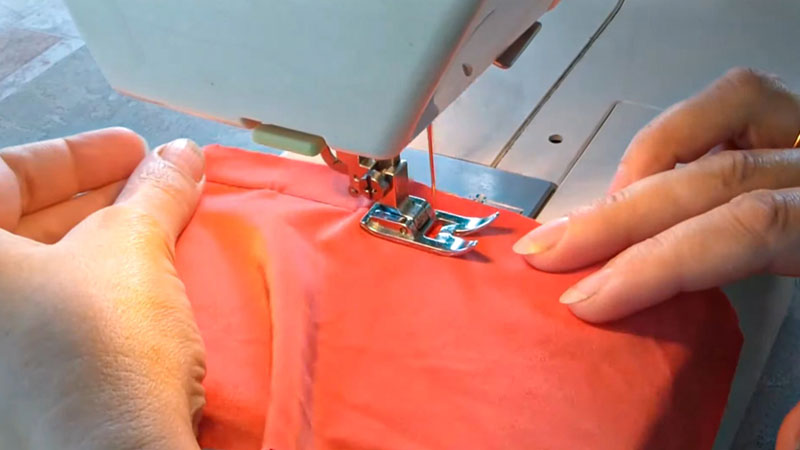Sewing with polyester, while popular for its durability and ease of care, can sometimes present challenges. One common issue is the occurrence of pulling during the sewing process.
This frustrating phenomenon involves the fabric becoming stretched or distorted as it moves through the machine, resulting in uneven seams.
Understanding the reasons behind polyester pulling is essential for any sewer working with this versatile synthetic fabric. Factors like tension settings, needle choice, and thread quality play significant roles.
This guide aims to shed light on the various causes behind polyester pulling, offering valuable insights and practical solutions for smoother, more successful sewing experiences with this material.

What Is Polyester Fabric?
Polyester fabric is a synthetic textile made from polymer fibers, primarily derived from petroleum. Known for its durability and versatility, polyester is popular in the fashion and textile industry.
It’s highly resistant to wrinkles, shrinking, and fading, making it a low-maintenance choice.
Polyester is often blended with other fibers for enhanced properties like stretch or moisture-wicking. Its smooth texture allows for vibrant dyeing, resulting in a wide range of colors and patterns.
Additionally, polyester is used in various applications, from clothing and home furnishings to industrial uses like sails and ropes.
Its affordability and easy care make it a prevalent choice in modern textile production.
Why Is My Polyester Pulling While Sewing?

Polyester fabric is a popular choice for sewing projects due to its durability, wrinkle resistance, and ease of care.
However, it can be frustrating when you encounter issues like “pulling” while sewing with polyester.
Pulling refers to the fabric getting stretched or distorted during the sewing process, leading to uneven seams and an unsightly finished product.
There are several reasons why polyester may pull while sewing:
Tension Settings
Incorrect tension settings on your sewing machine can lead to pulling. If the tension is too tight, it can cause the fabric to be pulled and stretched as it passes through the machine.
Conversely, if the tension is too loose, the stitches may not hold the fabric properly, leading to bunching and pulling.
Needle Choice
Using the wrong type or size of needle for polyester fabric can contribute to pulling.
Polyester is a lightweight fabric, so it’s best to use a fine or universal needle with a smaller size (between 70/10 and 80/12). A needle that’s too large or too sharp can damage the fabric and cause pulling.
Thread Type and Quality

The type and quality of thread you use can also affect how polyester fabric behaves during sewing. It’s essential to use a polyester thread that matches the fabric.
Low-quality or old thread can break easily, leading to pulling. Make sure your thread is in good condition and appropriate for the project.
Presser Foot Pressure
The pressure applied by the presser foot can be too high, causing the fabric to be pulled as it moves through the machine. Adjust the presser foot pressure according to your fabric’s thickness and type.
Stitch Length
Using an inappropriate stitch length can cause pulling. For polyester fabric, use a shorter stitch length (around 2.5 mm) to prevent excessive stretching between stitches.
Sewing Speed
Sewing too quickly can lead to pulling, especially if you’re not maintaining a steady pace.
Try sewing at a moderate, consistent speed to prevent the fabric from getting pulled or stretched unevenly.
Fabric Handling
Be mindful of how you handle the fabric while sewing. Pulling or tugging on the fabric as it feeds through the machine can distort it. Gently guide the fabric without applying excessive pressure.
Dull Machine Parts
Check your sewing machine’s parts, such as the needle, presser foot, and feed dogs, for damage or wear.
Dull or damaged components can cause the fabric to pull. Replace or maintain these parts as needed.
Fabric Grain
Ensure that you’re aligning the fabric’s grain properly before sewing. If the fabric is off-grain, it can lead to pulling and distortion as you sew.
Stabilizers
Depending on your project, you may need to use stabilizers or interfacing to prevent pulling.
These additional materials provide support and structure to the fabric, reducing the risk of distortion.
How to Sew Polyester Without Pulling?

To prevent pulling when sewing polyester, you need to prepare your fabric and your sewing machine properly.
Here are some tips and tricks that can help you sew polyester smoothly and successfully:
Preparing Your Fabric
Polyester fabrics can sometimes have excess dye or coatings, which can interfere with sewing and cause issues like pulling.
Before cutting and sewing, it’s essential to pre-wash your polyester fabric. This not only cleanses the fabric but also helps remove any residual chemicals.
Follow the fabric’s care instructions, usually a gentle cycle with cold or lukewarm water, and then tumble dry on low heat or air dry.
Needle Selection
The choice of the sewing machine needle is crucial when working with polyester fabric.
A fresh, sharp needle is essential to prevent pulling. For most polyester fabrics, a universal needle in size 70/10 or 80/12 is ideal.
However, for very lightweight or delicate polyester fabrics, consider using a microtex needle in size 60/8 or 70/10, which is designed for fine and lightweight materials.
On the other hand, for heavyweight polyester fabrics, like upholstery or outdoor fabrics, opt for a denim needle in size 90/14 or 100/16.
Thread Choice
Polyester thread is an excellent choice when sewing polyester fabric. It matches the fabric’s properties, such as strength and durability.
Choose a thread color that complements your fabric. Polyester threads are available in a wide range of colors, making it easy to find a perfect match. Ensure your thread is of high quality to prevent breakage and ensure longevity.
Adjusting Tension
Polyester can be sensitive to tension adjustments. It’s crucial to test and adjust your sewing machine’s tension settings on a scrap piece of polyester fabric before starting your project.
Ideally, the tension should be balanced, neither too tight nor too loose. Adjusting the tension ensures that your stitches are even and free from puckering or looping.
Adjusting Stitch Length
For polyester fabric, a shorter stitch length of 10 to 15 stitches per inch (approximately 2 to 2.5 mm) is recommended.
This shorter length helps prevent slipping or stretching of the fabric between stitches, resulting in a more secure and neater seam.
Presser Foot Pressure
Adjust the presser foot pressure on your sewing machine according to the thickness of your polyester fabric.
The goal is to have just enough pressure to hold the fabric securely in place without distorting it.
Experiment with different settings and test them on scrap fabric until you find the right balance.
Specialized Feet
If you’re working with slippery or stretchy polyester fabrics, consider using an even feed foot or a walking foot.
These specialty presser feet have built-in feed dogs that move in sync with the lower feed dogs of your sewing machine.
This helps feed the layers of fabric evenly, preventing shifting or puckering and ultimately reduces the chances of pulling.
Fabric Preparation
Polyester can be prone to melting under high heat, so use a low to medium heat setting on your iron when pressing your fabric.
Always place a pressing cloth between the iron and the fabric to protect it from direct contact. Gently press your polyester fabric to remove any wrinkles and create a smooth surface for sewing.
Cutting Techniques
Use sharp scissors or a rotary cutter with a fresh blade to cut your polyester fabric. Dull tools can cause the fabric to fray or distort during cutting.
Additionally, ensure that your cutting surface is clean and smooth. When cutting, follow the grainline of the fabric to prevent fraying and ensure that your pieces align correctly during sewing.
Pinning and Clipping
When pinning or clipping your fabric pieces together, use fine pins or clips.
Polyester can be slippery or stretchy, and using fine pins or clips helps minimize the risk of pulling the fabric.
Place the pins or clips close to the seam allowance, and remove them as you sew to avoid any resistance.
Sewing Technique
Sewing polyester requires a slow and steady pace. Avoid rushing or forcing the fabric through the machine.
Use gentle pressure on the pedal to maintain control over the stitching process. If you encounter resistance or pulling, stop, lift the presser foot, and gently reposition the fabric.
Seam Finishes
Polyester fabric can unravel easily at the edges, so it’s essential to finish your seams properly.
You can use a zigzag stitch, serger (overlock machine), or pinking shears to prevent fraying. Choose the seam finishing method that suits your fabric and your project’s needs.
FAQS
Why is my polyester fabric pulling while sewing?
Polyester pulling can occur due to factors like incorrect tension settings, inappropriate needle choice, or using low-quality thread.
How can I adjust tension settings to prevent pulling?
Test your machine’s tension on a scrap piece of polyester fabric. Adjust it gradually until stitches are balanced, neither too tight nor too loose, to prevent pulling.
What type of needle is best for sewing polyester?
For most polyester fabrics, a fine or universal needle (70/10 to 80/12) is recommended.
How can I prevent pulling on slippery polyester fabrics?
Consider using a walking foot attachment, which helps feed layers evenly. Additionally, a fine needle and adjusting presser foot pressure can aid in preventing pulling.
Why is it important to pre-wash polyester before sewing?
Pre-washing removes excess dye and coatings, ensuring a clean and relaxed fabric. This step helps prevent issues like pulling during sewing and improves overall project results.
To Wrap Up
Mastering the art of sewing with polyester involves overcoming challenges like fabric pulling.
By understanding and addressing factors like tension settings, needle selection, and thread quality, sewers can achieve seamless results.
Polyester’s durability and versatility make it a popular choice for various projects.
With these insights, you can confidently work with this fabric, creating garments and crafts that showcase its vibrant colors and resilience.
As you continue to refine your sewing skills, the ability to handle polyester adeptly opens up a world of creative possibilities.
Embrace the process and enjoy the journey of crafting with this versatile material. Happy sewing!
Leave a Reply